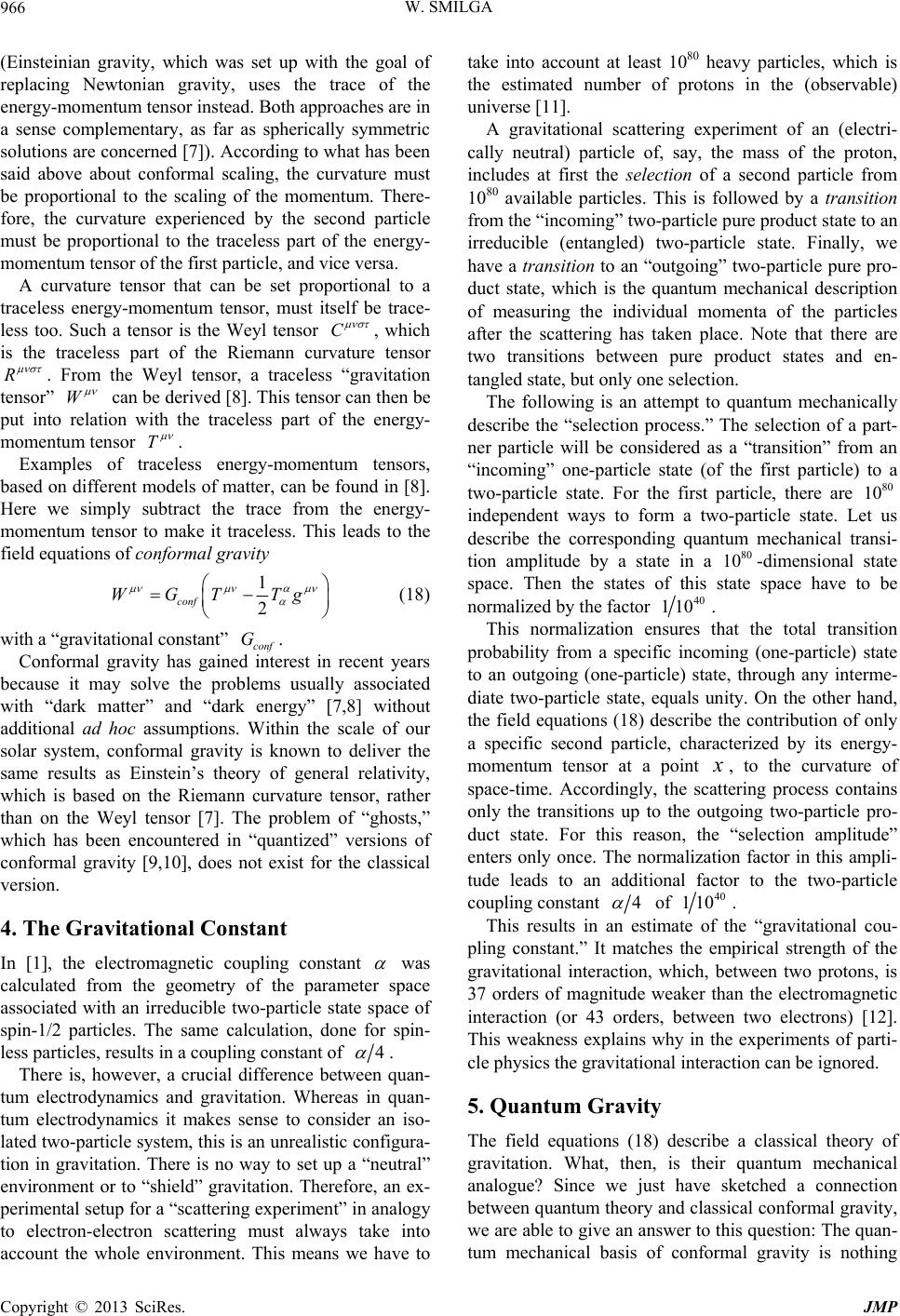
W. SMILGA
966
(Einsteinian gravity, which was set up with the goal of
replacing Newtonian gravity, uses the trace of the
energy-momentum tensor instead. Both approaches ar e in
a sense complementary, as far as spherically symmetric
solutions are concerned [7]). According to what has been
said above about conformal scaling, the curvature must
be proportional to the scaling of the momentum. There-
fore, the curvature experienced by the second particle
must be proportional to the traceless part of the energy-
momentum tensor of the first particle, and vice versa.
A curvature tensor that can be set proportional to a
traceless energy-momentum tensor, must itself be trace-
less too. Such a tensor is the Weyl tensor C
R
, which
is the traceless part of the Riemann curvature tensor
W
. From the Weyl tensor, a traceless “gravitation
tensor”
T
can be derived [8]. This tensor can then be
put into relation with the traceless part of the energy-
momentum tensor
.
Examples of traceless energy-momentum tensors,
based on different models of matter, can be found in [8].
Here we simply subtract the trace from the energy-
momentum tensor to make it traceless. This leads to the
field equations of c onformal gravity
1
2
T Tg
G
conf
WG
(18)
with a “gravitational constant” .
conf
Conformal gravity has gained interest in recent years
because it may solve the problems usually associated
with “dark matter” and “dark energy” [7,8] without
additional ad hoc assumptions. Within the scale of our
solar system, conformal gravity is known to deliver the
same results as Einstein’s theory of general relativity,
which is based on the Riemann curvature tensor, rather
than on the Weyl tensor [7]. The problem of “ghosts,”
which has been encountered in “quantized” versions of
conformal gravity [9,10], does not exist for the classical
version.
4. The Gravitational Constant
In [1], the electromagnetic coupling constant
was
calculated from the geometry of the parameter space
associated with an irreducible two-particle state space of
spin-1/2 particles. The same calculation, done for spin-
less particles, results in a coupling constant of 4
.
There is, however, a crucial difference between quan-
tum electrodynamics and gravitation. Whereas in quan-
tum electrodynamics it makes sense to consider an iso-
lated two-particle system, this is an unrealistic configura-
tion in gravitation. There is no way to set up a “neutral”
environment or to “shield” gravitation. Therefore, an ex-
perimental setup for a “scattering experiment” in analogy
to electron-electron scattering must always take into
account the whole environment. This means we have to
take into account at least 1080 heavy particles, which is
the estimated number of protons in the (observable)
universe [11].
A gravitational scattering experiment of an (electri-
cally neutral) particle of, say, the mass of the proton,
includes at first the selection of a second particle from
1080 available particles. This is followed by a transition
from the “incoming” two-particle pure product state to an
irreducible (entangled) two-particle state. Finally, we
have a transition to an “outgoing” two-particle pure pro-
duct state, which is the quantum mechanical description
of measuring the individual momenta of the particles
after the scattering has taken place. Note that there are
two transitions between pure product states and en-
tangled state, but only one selection.
The following is an attempt to quantum mechanically
describe the “selection process.” The selection of a part-
ner particle will be considered as a “transition” from an
“incoming” one-particle state (of the first particle) to a
two-particle state. For the first particle, there are
independent ways to form a two-particle state. Let us
describe the corresponding quantum mechanical transi-
tion amplitude by a state in a 10 -dimensional state
space. Then the states of this state space have to be
normalized by the factor
80
10
80
40
110 .
This normalization ensures that the total transition
probability from a specific incoming (one-particle) state
to an outgoing (one-particle) state, through any interme-
diate two-particle state, equals unity. On the other hand,
the field equations (18) describe the contribution of only
a specific second particle, characterized by its energy-
momentum tensor at a point
, to the curvature of
space-time. Accordingly, the scattering process contains
only the transitions up to the outgoing two-particle pro-
duct state. For this reason, the “selection amplitude”
enters only once. The normalization factor in this ampli-
tude leads to an additional factor to the two-particle
coupling constant 40
0 of 11 .
4
This results in an estimate of the “gravitational cou-
pling constant.” It matches the empirical strength of the
gravitational interaction, which, between two protons, is
37 orders of magnitude weaker than the electromagnetic
interaction (or 43 orders, between two electrons) [12].
This weakness explains why in the experiments of parti-
cle physics the gravitational interaction can be ignored.
5. Quantum Gravity
The field equations (18) describe a classical theory of
gravitation. What, then, is their quantum mechanical
analogue? Since we just have sketched a connection
between quantum theory and classical conformal gravity,
we are able to give an answer to this question: The quan-
tum mechanical basis of conformal gravity is nothing
Copyright © 2013 SciRes. JMP